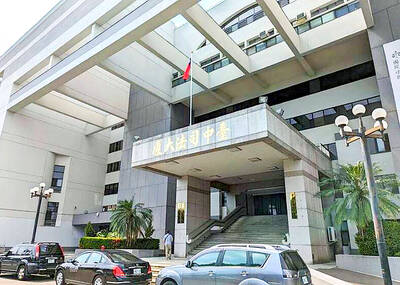The devastating earthquake and tsunami that hit Japan on March 11 prompted Taiwanese scientists to develop earthquake early warning technology and highlighted the need to set up topography models for the rapid deployment of search and rescue teams in the event of natural catastrophes.
Liu Chi-ching (劉啟清) of the Institute for Earth Sciences at Academia Sinica said the tectonic plates under Taiwan were the most active globally.
Some of the nation’s mountains are growing by between 1cm and 3cm annually and foothill areas are becoming steeper. Liu said this showed mountain faces were being worn down by erosion.
Earlier methods to stabilize slopes and prevent rockfalls, which involved layering mountainsides with cement, are now considered unsuitable when it came to holding up against seismic activity, Liu said.
“Typhoons, earthquakes and mudslides are all likely to cause disasters and the best way to prevent that is to monitor geological activity using scientific methods,” Liu said.
Yu Ting-to (余騰鐸), a professor at National Cheng Kung University’s department of resource engineering, said the technology used for national geological imaging was based largely on aerial or satellite imaging.
However, satellite imaging is largely contingent on weather conditions and photos cannot be taken during bad weather, Yu said, adding that aerial imaging was also limited in terms of imaging airspace clearance.
To address those limitations, academics are suggesting the adoption of a new technology known as Light Detection and Ranging (LIDAR), a terrestrial-based or airborne system that emits as many as 400,000 laser pulses in less than a second to render 3D images, even of underground locations.
LIDAR also has sharper image resolution and faster scanning speeds, with precision levels to within between 3cm and 10cm. By comparison, current aerial imaging has a resolution of between 20cm and 50cm.
LIDAR is an optical remote sensing technology that can measure the distance to a target, or other properties of an object, by illuminating the target with light using pulses from a laser.
Liu said that by using LIDAR to scan the Alishan (阿里山) area, for example, a detailed topographical imaging could be achieved showing roads, railroads, the location of trees, their altitude and even the way tree-branches are extended, all of which could be beneficial for forestry management.
Liu said LIDAR monitoring data could help with early warnings for mudslides, landslides and flooding when used in tandem with satellite and aerial imaging.
The Institute for Earth Sciences is already using LIDAR technology on a large scale and plans to complete high-resolution digital topography models of disaster areas created by Typhoon Morakot, which devastated parts of the south of the nation in 2009, to help them investigate geologically sensitive areas.
Central Geological Survey director Lin Chao-tsung (林朝宗) said the center had already used airborne LIDAR systems to evaluate potential geological disasters in the Taipei basin, as well as in the mountain ranges along the eastern coast.

EVA Airways today confirmed the death of a flight attendant on Saturday upon their return to Taiwan and said an internal investigation has been launched, as criticism mounted over a social media post accusing the airline of failing to offer sufficient employee protections. According to the post, the flight attendant complained of feeling sick on board a flight, but was unable to take sick leave or access medical care. The crew member allegedly did not receive assistance from the chief purser, who failed to heed their requests for medical attention or call an ambulance once the flight landed, the post said. As sick

A drunk woman was sexually assaulted inside a crowded concourse of Taipei Railway Station on Thursday last week before a foreign tourist notified police, leading to calls for better education on bystander intervention and review of security infrastructure. The man, surnamed Chiu (邱), was taken into custody on charges of sexual assault, taking advantage of the woman’s condition and public indecency. Police discovered that Chiu was a fugitive with prior convictions for vehicle theft. He has been taken into custody and is to complete his unserved six-month sentence, police said. On Thursday last week, Chiu was seen wearing a white

EVA Airways, one of the leading international carriers in Taiwan, yesterday said that it was investigating reports that a cabin crew manager had ignored the condition of a sick flight attendant, who died on Saturday. The airline made the statement in response to a post circulating on social media that said that the flight attendant on an outbound flight was feeling sick and notified the cabin crew manager. Although the flight attendant grew increasingly ill on the return flight, the manager did not contact Medlink — a system that connects the aircraft to doctors on the ground for treatment advice during medical

The Taichung District Court yesterday confirmed its final ruling that the marriage between teenage heir Lai (賴) and a man surnamed Hsia (夏) was legally invalid, preventing Hsia from inheriting Lai’s NT$500 million (US$16.37 million) estate. The court confirmed that Hsia chose not to appeal the civil judgement after the court handed down its ruling in June, making the decision final. In the June ruling, the court said that Lai, 18, and Hsia, 26, showed “no mutual admiration before the marriage” and that their interactions were “distant and unfamiliar.” The judge concluded that the couple lacked the “true intention of